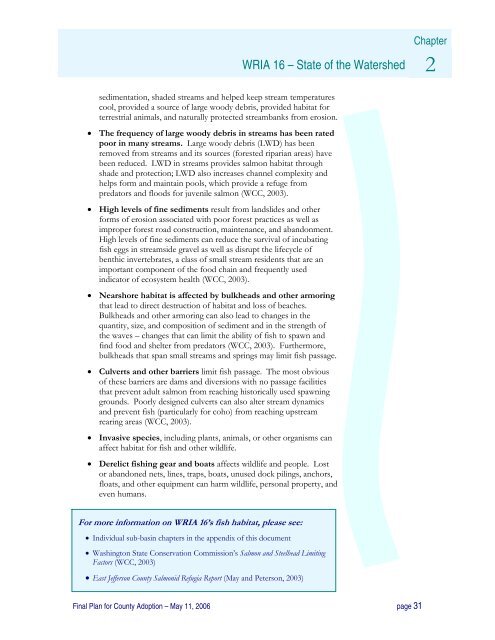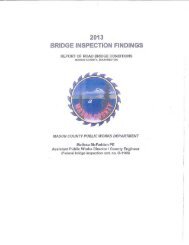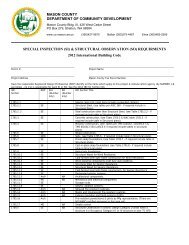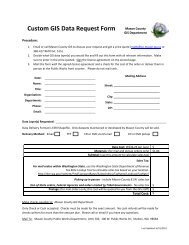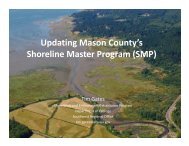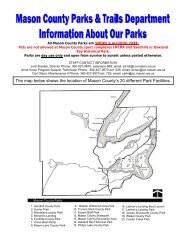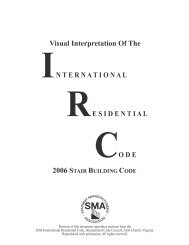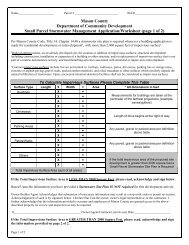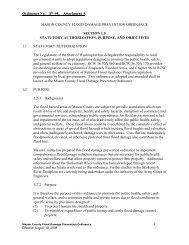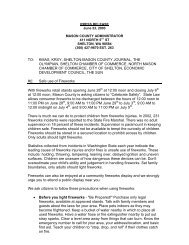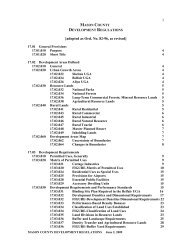Watershed Management Plan - Mason County
Watershed Management Plan - Mason County
Watershed Management Plan - Mason County
Create successful ePaper yourself
Turn your PDF publications into a flip-book with our unique Google optimized e-Paper software.
Chapter<br />
WRIA 16 – State of the <strong>Watershed</strong> 2<br />
sedimentation, shaded streams and helped keep stream temperatures<br />
cool, provided a source of large woody debris, provided habitat for<br />
terrestrial animals, and naturally protected streambanks from erosion.<br />
• The frequency of large woody debris in streams has been rated<br />
poor in many streams. Large woody debris (LWD) has been<br />
removed from streams and its sources (forested riparian areas) have<br />
been reduced. LWD in streams provides salmon habitat through<br />
shade and protection; LWD also increases channel complexity and<br />
helps form and maintain pools, which provide a refuge from<br />
predators and floods for juvenile salmon (WCC, 2003).<br />
• High levels of fine sediments result from landslides and other<br />
forms of erosion associated with poor forest practices as well as<br />
improper forest road construction, maintenance, and abandonment.<br />
High levels of fine sediments can reduce the survival of incubating<br />
fish eggs in streamside gravel as well as disrupt the lifecycle of<br />
benthic invertebrates, a class of small stream residents that are an<br />
important component of the food chain and frequently used<br />
indicator of ecosystem health (WCC, 2003).<br />
• Nearshore habitat is affected by bulkheads and other armoring<br />
that lead to direct destruction of habitat and loss of beaches.<br />
Bulkheads and other armoring can also lead to changes in the<br />
quantity, size, and composition of sediment and in the strength of<br />
the waves – changes that can limit the ability of fish to spawn and<br />
find food and shelter from predators (WCC, 2003). Furthermore,<br />
bulkheads that span small streams and springs may limit fish passage.<br />
• Culverts and other barriers limit fish passage. The most obvious<br />
of these barriers are dams and diversions with no passage facilities<br />
that prevent adult salmon from reaching historically used spawning<br />
grounds. Poorly designed culverts can also alter stream dynamics<br />
and prevent fish (particularly for coho) from reaching upstream<br />
rearing areas (WCC, 2003).<br />
• Invasive species, including plants, animals, or other organisms can<br />
affect habitat for fish and other wildlife.<br />
• Derelict fishing gear and boats affects wildlife and people. Lost<br />
or abandoned nets, lines, traps, boats, unused dock pilings, anchors,<br />
floats, and other equipment can harm wildlife, personal property, and<br />
even humans.<br />
For more information on WRIA 16’s fish habitat, please see:<br />
• Individual sub-basin chapters in the appendix of this document<br />
• Washington State Conservation Commission’s Salmon and Steelhead Limiting<br />
Factors (WCC, 2003)<br />
• East Jefferson <strong>County</strong> Salmonid Refugia Report (May and Peterson, 2003)<br />
Final <strong>Plan</strong> for <strong>County</strong> Adoption – May 11, 2006 page 31


